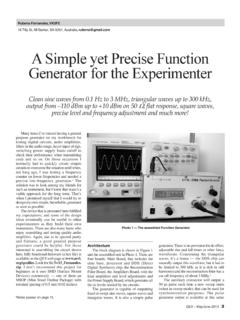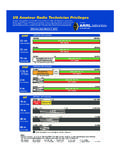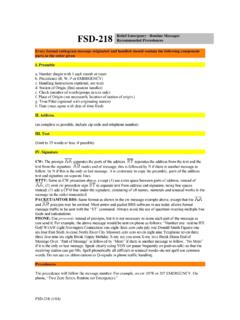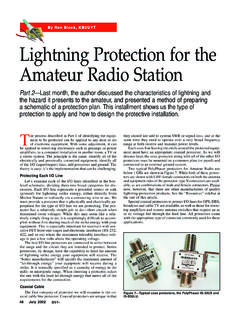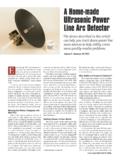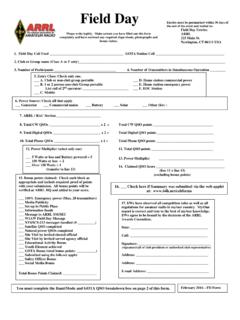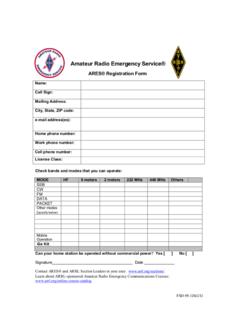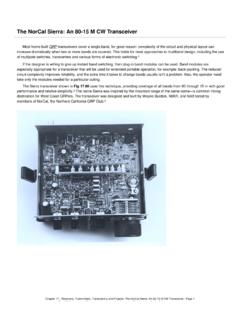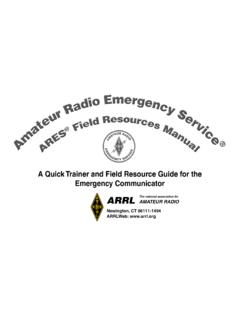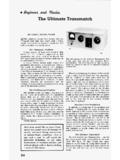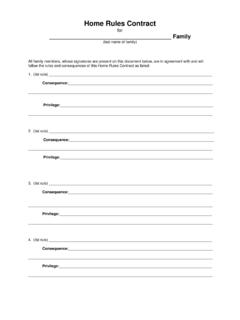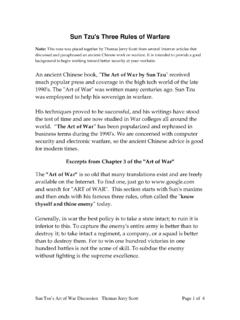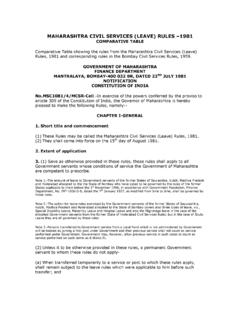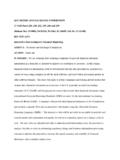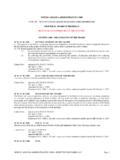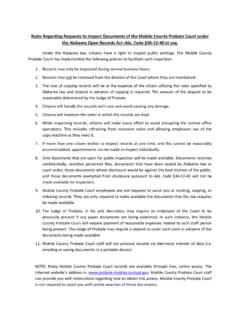Transcription of ARRL Field Day 2016 Rules
1 arrl Field Day 2016 Rules 1. Eligibility: Field Day is open to all amateurs in the areas covered by the arrl /RAC Field Organizations and countries within IARU Region 2. DX stations residing in other regions may be contacted for credit, and may submit entries as check-logs. 2. Object: To work as many stations as possible on any and all amateur bands (excluding the 60, 30, 17, and 12- meter bands) and in doing so to learn to operate in abnormal situations in less than optimal conditions. A premium is placed on developing skills to meet the challenges of emergency preparedness as well as to acquaint the general public with the capabilities of Amateur Radio. 3. Date and Time Period: Field Day is always the fourth full weekend, beginning at 1800 UTC Saturday and ending at 2100 UTC Sunday. Field Day 2016 will be held June 25-26, 2016 . Class A and B (see below) stations that do not begin setting up until 1800 UTC on Saturday may operate the entire 27-hour Field Day period.
2 Stations who begin setting up before 1800 UTC Saturday may work only 24 consecutive hours, commencing when on-the-air operations begin. No class A or B station may begin its set-up earlier than 0000 UTC on the Friday (Thursday afternoon or evening local time) preceding the Field Day period. Cumulative set-up time shall not exceed a total of 24 hours. 4. Entry Categories: 4. Entry Categories: Field Day entries are classified according to the maximum number of simultaneously transmitted signals, followed by a designator indicating the nature of their individual or group participation. The minimum number of transmitters that must be claimed is one (1). Twenty (20) transmitters maximum are eligible for the purpose of calculating bonus points (2,000 points maximum). However, additional transmitters which may legitimately be used simultaneously will determine your entry category classification, but will not earn additional bonus points ( 22 transmitters = 22A).
3 The use of switching systems that allow for lock- outs in order to use multiple transmitters ( , an octopus ) in an attempt to enter a lower-number-of-transmitters class are prohibited ( using 2 transmitters that can transmit simultaneously, with two operators, and a lock-out system and entering class 1A). The use of simulcasting devices which allow a single operator to key and transmit on more than one transmitter at a time, is prohibited. Bonus stations, such as the GOTA station and satellite station do not count towards determining the number of transmitters for the class and do not qualify for transmitter bonus points. (Class A) Club / non-club portable: Club or a non-club group of three or more persons set up specifically for Field Day. Such stations must be located in places that are not regular station locations and must not use facilities installed for permanent station use, or use any structure installed permanently for Field Day.
4 A single licensee or trustee for the entry is responsible for the group entry. All equipment (including antennas) must lie within a circle whose diameter does not exceed 300 meters (1000 feet). To be listed as Class A, all contacts must be made with transmitter(s) and receiver(s) operating independent of commercial power mains. Entrants whom for any reason operate a transmitter or receiver from a commercial main for one or more contacts will be listed separately as Class A-Commercial. Get-On-The-Air (GOTA) Station. Any Class A (or F) entry whose transmitter classification is two or more transmitters may also operate one additional station without changing its base entry category, known as the GET-ON-THE-AIR (GOTA) station. This GOTA station may operate on any Field Day band, HF or VHF, but is limited to one GOTA station transmitted signal at any time. This station must use a different callsign from the primary Field Day station. The GOTA station must use the same callsign for the duration of the event regardless if operators change.
5 The GOTA station uses the same exchange as its parent. The GOTA station may be operated by any person licensed since the previous year's Field Day, regardless of license class. It may also be operated by a generally inactive licensee. Non-licensed persons may participate under the direct supervision of an appropriate control operator. A list of operators and participants must be included on the required summary sheet to arrl HQ. As per FCC Rules , this station must have a valid control operator present at the control point if operating beyond the license privileges of the participant using the station. The maximum transmitter output power for the GOTA station shall be 150 watts. If the primary Field Day group is claiming the QRP multiplier level of 5, the maximum transmitter output power of the GOTA station may not exceed 5 watts. A maximum of 500 QSOs made by this station may be claimed for credit by its primary Field Day operation. In addition, bonus points may be earned by this station under rule The GOTA station may operate on any Field Day band.
6 Only one transmitted signal is allowed from the GOTA station at any time. The GOTA station does not affect the additional VHF/UHF station provided for under Field Day Rule for Class A stations. Participants are reminded that non-licensed participants working under the direction of a valid control operator may only communicate with other W/VE stations or with stations in countries with which the US has entered a third-party agreement. The GOTA station does not qualify as an additional transmitter when determining the number of transmitters eligible for the 100-point emergency power bonus under Rule Free VHF Station: All Class A entries may also operate one additional transmitter if it operates exclusively on any band or combination of bands above 50 MHz (VHF/UHF). without changing its basic entry classification. This station does not qualify for a 100-point bonus as an additional transmitter. This station may be operated for the clubs Field Day period and all contacts count for QSO credit.
7 It is operated using the primary callsign and exchange of the main Field Day group and is separate and distinct from the GOTA station. (Class A - Battery) Club / non-club portable: Club or non-club group of three or more persons set up specifically for Field Day. All contacts must be made using an output power of 5 Watts or less and the power source must be something other than commercial power mains or motor-driven generator ( : batteries, solar cells, water-driven generator). Other provisions are the same for regular Class A. Class AB is eligible for a GOTA station if GOTA requirements are met; however if a GOTA station is used in this class it must meet the 5-Watt or less power requirement of this category. (Class B) One or two person portable: A Field Day station set up and operated by no more than two persons. Other provisions are the same for Class A except it is not eligible for a GOTA or free VHF station. One and two person Class B entries will be listed separately.
8 (Class B - Battery) One or two person portable: A Field Day station set up and operated by no more than two persons. All contacts must be made using an output power of 5 Watts or less and the power source must be something other than commercial mains or motor-driven generator. Other provisions are the same for Class A except it is not eligible for a GOTA or free VHF station. One and two person Class B - Battery entries will be listed separately. (Class C) Mobile: Stations in vehicles capable of operating while in motion and normally operated in this manner. This includes maritime and aeronautical mobile. If the Class C station is being powered from a car battery or alternator, it qualifies for emergency power but does not qualify for the multiplier of 5, as the alternator/battery system constitutes a motor-driven generating system. (Class D) Home stations: Stations operating from permanent or licensed station locations using commercial power.
9 Class D stations may only count contacts made with Class A, B, C, E and F Field Day stations. (Class E) Home stations - Emergency power: Same as Class D, but using emergency power for transmitters and receivers. Class E may work all Field Day stations. (Class F) Emergency Operations Centers (EOC): An amateur radio station at an established EOC. activated by a club or non-club group. Class F operation must take place at an established EOC site. Stations may utilize equipment and antennas temporarily or permanently installed at the EOC for the event. Entries will be reported according to number of transmitters in simultaneous operation. Class F stations are eligible for a free VHF. station. At Class 2F they are also eligible for a GOTA station. For Field Day purposes, an Emergency Operations Center (EOC) is defined as a facility established by: a) a Federal, State, County, City or other Civil Government, agency or administrative entity; or, b) a Chapter of a national or international served agency (such as American Red Cross or Salvation Army) with which your local group has an established operating arrangement.
10 A private company EOC does not qualify for Class F status unless approved by the arrl Field Day Manager. Planning of a Class F operation must take place in conjunction and cooperation with the staff of the EOC being activated. Other provisions not covered are the same as Class A. A Class F station may claim the emergency power bonus if emergency power is available at the EOC site. The emergency power source must be tested during the Field Day period but you are not required to run the Class F operation under emergency power. 5. Exchange: Stations in arrl / RAC sections will exchange their Field Day operating Class and arrl / RAC. section. Example: a three transmitter class A station in Connecticut which also has a GOTA station and the extra VHF station would send "3A CT" on CW or "3 Alpha Connecticut" on Phone. DX stations send operating class and the term DX ( 2A DX). 6. Miscellaneous Rules : A person may not contact for QSO credit any station from which they also participate.
